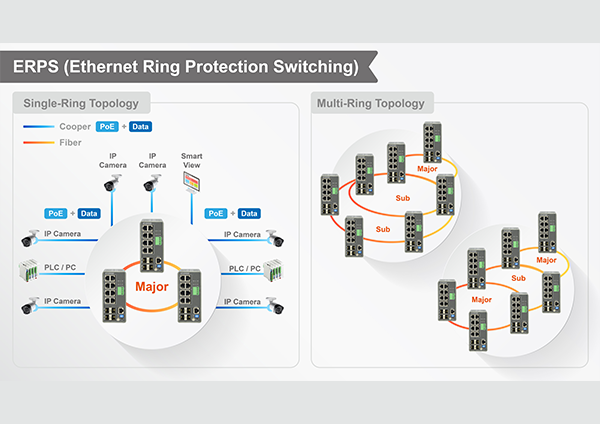Ethernet Ring Protection Switching Solution
Ethernet Ring Protection Switching, or ERPS, is an effort at ITU-T under G.8032 Recommendation to provide sub-50ms protection and recovery switching for Ethernet traffic in a ring topology and at the same time ensuring that there are no loops formed at the Ethernet layer. G.8032v1 supported a single ring topology and G.8032v2 supports multiple rings/ladder topology.
ERPS specifies protection switching mechanisms and a protocol for Ethernet layer network (ETH) rings. Ethernet Rings can provide wide-area multipoint connectivity more economically due to their reduced number of links. The mechanisms and protocol defined in this Recommendation achieve highly reliable and stable protection; and never form loops, which would fatally affect network operation and service availability.
Each Ethernet Ring Node is connected to adjacent Ethernet Ring Nodes participating in the same Ethernet Ring, using two independent links. A ring link is bounded by two adjacent Ethernet Ring Nodes, and a port for a ring link is called a ring port. The minimum number of Ethernet Ring Nodes in an Ethernet Ring is three.
The fundamentals of this ring protection switching architecture are:
a) The principle of loop avoidance.
b) The utilization of learning, forwarding, and Filtering Database (FDB) mechanisms defined in the Ethernet flow forwarding function (ETH_FF).
Loop avoidance in an Ethernet Ring is achieved by guaranteeing that, at any time, traffic may flow on all but one of the ring links. This particular link is called the Ring Protection Link (RPL), and under normal conditions this ring link is blocked, i.e. not used for service traffic. One designated Ethernet Ring Node, the RPL Owner Node, is responsible for blocking traffic at one end of the RPL. Under an Ethernet ring failure condition, the RPL Owner Node is responsible for unblocking its end of the RPL (unless the RPL has failed) allowing the RPL to be used for traffic. The other Ethernet Ring Node adjacent to the RPL, the RPL Neighbour Node, may also participate in blocking or unblocking its end of the RPL.
The event of an Ethernet Ring failure results in protection switching of the traffic. This is achieved under the control of the ETH_FF functions on all Ethernet Ring Nodes. An APS protocol is used to coordinate the protection actions over the ring.


